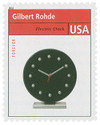
# 4546l - 2011 First-Class Forever Stamp - Pioneers of American Design: Gilbert Rohde - Electric Clock
U.S. #4546l
2011 44¢ Pioneers of American Industrial Design –
Gilbert Rohde
Issue Date: June 29, 2011
City: New York, NY
Quantity: 36,000,000
Printed By: Avery Dennison
Printing Method: Photogravure
Color: multicolored
Atrip to Europe transfigured designer Gilbert Rohde’s career. After visiting the Bauhaus School in Germany, Rohde (1894-1944) was impressed by its dedication to sleek modernism and idea of an item’s function being critical to its form. The son of a cabinetmaker, Rohde had been working as a catalogue illustrator. Bauhaus changed all that.
The institute was perhaps the first school specializing in modernist design. Rohde absorbed its concepts and brought them back to the U.S. He opened a design business, and soon a contract with then-struggling Herman Miller Furniture Company gave him the platform to display his vision.
Rohde convinced owner Dirk Jan De Pree that the decreasing size of modern homes required furniture that was more functional and less ornate. De Pree agreed, and Rohde had his first designs ready by the start of the 1933 Chicago World’s Fair, where they were a great success. By 1939, Rohde had expanded his designs into office furniture.
Rohde believed in multi-purpose designs, such as a coffee table doubling as a bookcase. His designs often could be altered to suit an owner’s needs, such as the sectional sofa he first introduced. Rohde’s modular, streamlined approach marked an important shift in how Americans view their homes.
U.S. #4546l
2011 44¢ Pioneers of American Industrial Design –
Gilbert Rohde
Issue Date: June 29, 2011
City: New York, NY
Quantity: 36,000,000
Printed By: Avery Dennison
Printing Method: Photogravure
Color: multicolored
Atrip to Europe transfigured designer Gilbert Rohde’s career. After visiting the Bauhaus School in Germany, Rohde (1894-1944) was impressed by its dedication to sleek modernism and idea of an item’s function being critical to its form. The son of a cabinetmaker, Rohde had been working as a catalogue illustrator. Bauhaus changed all that.
The institute was perhaps the first school specializing in modernist design. Rohde absorbed its concepts and brought them back to the U.S. He opened a design business, and soon a contract with then-struggling Herman Miller Furniture Company gave him the platform to display his vision.
Rohde convinced owner Dirk Jan De Pree that the decreasing size of modern homes required furniture that was more functional and less ornate. De Pree agreed, and Rohde had his first designs ready by the start of the 1933 Chicago World’s Fair, where they were a great success. By 1939, Rohde had expanded his designs into office furniture.
Rohde believed in multi-purpose designs, such as a coffee table doubling as a bookcase. His designs often could be altered to suit an owner’s needs, such as the sectional sofa he first introduced. Rohde’s modular, streamlined approach marked an important shift in how Americans view their homes.












